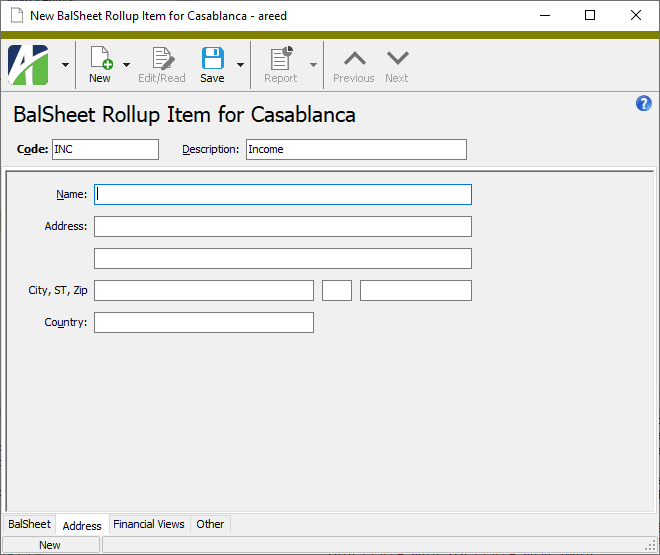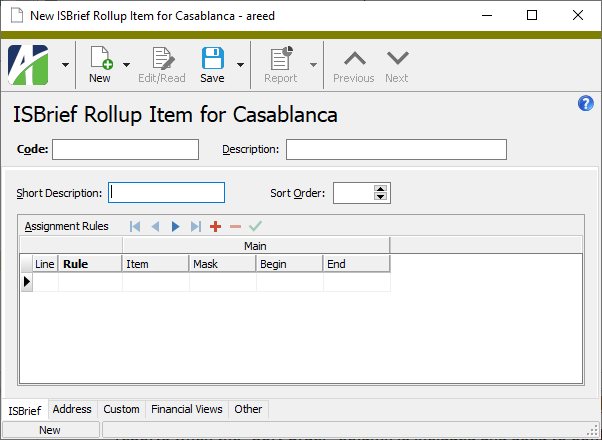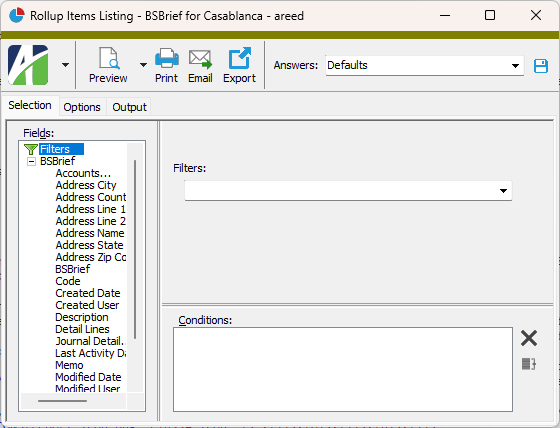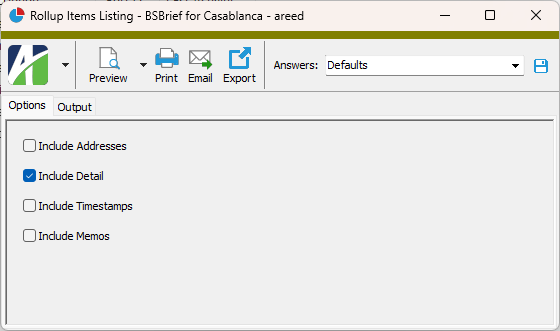Rollup items typically represent lines of a financial statement. Rollup items are defined by the segment items and/or rollup items or combinations they include.
Example
You could use a rollup item to combine all segment items and/or rollup items that would go into the Accounts Receivable line on a balance sheet.
![]() Create a direct-assignment rollup item
Create a direct-assignment rollup item
Create a direct assignment rollup item
- In the Navigation pane, select the General Ledger > Setup > Rollups folder and then select the folder for the type of rollup item you need to create.
- Click
 . The New Rollup Item window opens.
. The New Rollup Item window opens.
- Enter a unique Code for the rollup item. The length and data type for the code depend on how the associated rollup is set up.
- Enter a Description of the rollup item. You can use up to 60 characters.
- Enter a Short Description of the rollup item. You can use up to 20 characters.
- In the Sort Order field, enter the order in which you want the rollup item to appear in the HD view and on financial view reports when the "Sort Order" column is included and used to control line order. If no sort order is specified on a new rollup item, it is automatically added to the end of the sort order.
-
If the rollup item is associated with a particular address, select the Address tab. Otherwise, skip to step 9.

- Enter the name and address to associate with the rollup item.
- Save the new rollup item.
![]() Create a rules-based rollup item
Create a rules-based rollup item
Create a rules-based rollup item
- In the Navigation pane, select the General Ledger > Setup > Rollups folder and then select the folder for the type of rollup item you need to create.
- Click
 . The New Rollup Item window opens.
. The New Rollup Item window opens.
- Enter a unique Code for the rollup item. The length and data type for the code depend on how the associated rollup is set up.
- Enter a Description of the rollup item. You can use up to 60 characters.
- Enter a Short Description of the rollup item. You can use up to 20 characters.
- In the Sort Order field, enter the order in which you want the rollup item to appear in the HD view and on financial view reports when the "Sort Order" column is included and used to control line order. If no sort order is specified on a new rollup item, it is automatically added to the end of the sort order.
- In the table, do one of the following for each segment and/or rollup assigned to the associated rollup item. If there are multiple segments and/or rollups, use them in combination to define the combinations of segment items and/or rollup items to include.
- In the Rule column, select the type of rule to use. Your choices are:
- Include
- Exclude
Note
If an include rule and exclude rule both reference the same item, the exclude rule will be followed. For example, if one rule includes accounts with a main segment in the range 1500-1599, and another rule excludes accounts assigned a main segment of 1527, then the rollup will include accounts with main segments 1500-1526 and 1528-1599.
- In the Item column, select the segment item or rollup item to include in the rollup item.
- In the Mask column, select the segment item mask or rollup item mask to use to select the segment items or rollup items to include in the rollup item. Use this option when the items you are rolling up have common characters but are not in a particular order.
- In the Begin and End fields, enter the range of segment items or rollup items to include in the rollup item.
- In the Rule column, select the type of rule to use. Your choices are:
- Add more lines to the table until you have described all the segment items and/or rollup items you need to include in the rollup item.
- If the rollup item is associated with a particular address, select the Address tab. Otherwise, skip to step 11.

- Enter the name and address to associate with the rollup item.
- Save the new rollup item.
A rollup item cannot be deleted if it has any references.
To delete a rollup item that is not in use, highlight the rollup item in the HD view and click ![]() , or open the rollup item and select
, or open the rollup item and select ![]() > Edit > Delete. In either case, ActivityHD prompts you to confirm your action. Click Delete to delete the rollup item.
> Edit > Delete. In either case, ActivityHD prompts you to confirm your action. Click Delete to delete the rollup item.
Rollup Items Listing
Purpose
The Rollup Items Listing provides a list of items defined for a particular rollup.
Content
For each rollup item included on the report, the listing shows:
- description
- short description.
In addition, you can include one or more of the following:
- addresses
- detail (line number, assigned segment, segment/rollup item, mask, begin segment/rollup item, end segment/rollup item) [Not available on direct assignment rollups.]
- timestamps
- memos
- custom fields.
The following total appears on the report:
- record count.
Print the report
- In the Navigation pane, expand the General Ledger > Setup > Rollups folder and highlight the folder for the rollup items you want to report on.
- Start the report set-up wizard.
- To report on all or a filtered subset of rollup items:
- Right-click the rollup items folder and select Select and Report > Rollup Items Listing from the shortcut menu.
- On the Selection tab, define any filters to apply to the data.

- To report on specifically selected rollup items:
- In the HD view, select the rollup items to include on the report. You can use Ctrl and/or Shift selection to select multiple records.
- Click
 .
.
- To report on a particular rollup item from the Rollup Item window:
- In the HD view, locate and double-click the rollup item to report on. The Rollup Item window opens with the rollup item loaded.
- Click
 .
.
- To report on all or a filtered subset of rollup items:
- Select the Options tab.

- Mark the checkbox(es) for the additional information to include:
- Addresses
- Detail (not visible when reporting on direct assignment rollups)
- Report Options. To include a section at the end of the report with the report settings used to produce the report, leave the checkbox marked. To produce the report without this information, clear the checkbox.
- Timestamps
- Memos
- Custom Fields (only visible if custom fields are set up)
- Select the Output tab.
- In the Design field, look up and select the report design to use.
- In the toolbar, click the icon for the type of output you want:
 - Provides access to two preview options.
- Provides access to two preview options.- Preview - Click the icon or click the drop-down arrow and select Preview from the drop-down menu to view the report in the Crystal Reports viewer.
- Preview to PDF - Click the drop-down arrow next to the icon and select Preview to PDF to view the report in the PDF reader.
 - Opens the Print dialog so that you can select and configure a printer and then print a paper copy of the report.
- Opens the Print dialog so that you can select and configure a printer and then print a paper copy of the report. - Opens the Report Email dialog so that you can address and compose an email that the report will be attached to. For best results, ensure your email client is running before you attempt to send a report via email.
- Opens the Report Email dialog so that you can address and compose an email that the report will be attached to. For best results, ensure your email client is running before you attempt to send a report via email. - Opens the Export Report dialog so that you can save the report to a file. File types include Crystal Reports (.rpt), PDF (.pdf), Microsoft Excel (.xls), Microsoft Word (.doc), rich text (.rtf), and XML (.xml).
- Opens the Export Report dialog so that you can save the report to a file. File types include Crystal Reports (.rpt), PDF (.pdf), Microsoft Excel (.xls), Microsoft Word (.doc), rich text (.rtf), and XML (.xml).
Data extensions
The following data extension is available for the report:
- Rollup items
Rollup Item Record ID
[Rollup Name] tab
- Include
- Exclude
If no rule type is selected, ActivityHD defaults to Include.
Note
If an include rule and exclude rule both reference the same item, the exclude rule will be followed. For example, if one rule includes accounts with a main segment in the range 1500-1599, and another rule excludes accounts assigned a main segment of 1527, then the rollup will include accounts with main segments 1500-1526 and 1528-1599.
If you are designating a specific segment item or rollup item, the segment item or rollup item to include in this rollup item.
Press F3 to look up the value.
If a value is already selected, you can press F4 to open the record in its native editor.
If you are selecting segment items or rollup items by segment item mask or by rollup item mask, enter the mask to use to select the items to include in this rollup item. Use this option when the items you are rolling up have common characters but are not in a particular order.
Press F3 to look up the value.
If a value is already selected, you can press F4 to open the record in its native editor.
If you are selecting a range of segment items or rollup items, enter the first segment item or rollup item of the range of items to include in this rollup item.
Press F3 to look up the value.
If a value is already selected, you can press F4 to open the record in its native editor.
If you are selecting a range of segment items or rollup items, enter the last segment item or rollup item of the range of items to include in this rollup item.
Press F3 to look up the value.
If a value is already selected, you can press F4 to open the record in its native editor.
Address tab
Enter information on this tab only if the rollup item represents a location such as a region or store number.
Custom tab
This tab is visible if custom fields exist for the entity. At a minimum, if there are custom fields, a Fields subtab will be present. One or more additional categories of subtabs may also be visible.
Fields subtab
This tab prompts for values for any custom fields set up for entity records of this entity type. Respond to the prompts as appropriate.
References subtab
This tab is visible if other records reference the current record.
Example
Suppose a custom field exists on PRCodes that references an ARCode. On the ARCode record, on the Custom > References subtab, you can view all the PRCodes which reference that ARCode.
Exchange Folder subtab
This tab is visible only if you set up a custom field with a data type of "Exchange Folder". The label on this tab is the name assigned to the custom field.
This tab shows the contents of the specified Exchange folder.
File subtab
This tab is visible only if you set up a custom field with a data type of "File". The label on the tab is the name assigned to the custom field.
This tab renders the contents of the specified file according to its file type.
Internet Address subtab
This tab is visible only if you set up a custom field with a data type of "Internet Address". The label on this tab is the name assigned to the custom field.
This tab shows the contents of the specified web page.
Network Folder subtab
This tab is visible only if you set up a custom field with a data type of "Network Folder". The label on this tab is the name assigned to the custom field.
This tab shows the contents of the specified network folder.
Chart of Accounts tab
The Chart of Accounts pane shows the Accounts HD view filtered to show all accounts associated with the selected rollup item.
Double-click a row in the pane to drill down to its record in the Account window.
Journal Detail tab
The Journal Detail pane shows the Journal Detail HD view filtered to show all journal detail lines for accounts associated with the rollup item.
Double-click a row in the pane to drill down to its record in the Journal Detail window.
Financial Views tab
One tab appears in this area for each active account-level financial view. Select the tab for the financial view you want to view totals for.
Depending on how the columns in a financial view are defined, you can view rollup item totals such as period beginning balance, period activity, period ending balance, year-to-date activity, activity for the month, activity for the quarter, etc. Use the filters above the tabs to select the period to view totals for and to include or exclude unmerged entries.
Double-click a row in the pane to drill down to its record in the Financial View Item window, then highlight a total to view the journal detail entries which comprise the total.
Example
Suppose you have a rollup named "Income Statement" which defines the line items on your income statement. You can create a financial view which iterates the Income Statement rollup and the Department segment. This financial view will show the income statement line items broken down by department. For the purpose of this example, we'll call this financial view "Income Statement by Department". If you open a specific Income Statement rollup item from the HD view, the Financial Views tab will have a subtab named "Income Statement by Department" which is filtered for the current income statement item. The subtab shows the department subtotals for that particular item. You can change the accounting period you are viewing by selecting new values in the Period field at the top of the tab.
Attachments tab
The Attachments tab is visible if any record for a given entity has an attachment. If the Attachments tab is not visible, this implies that no record of the entity type has an attachment on it; however, once an attachment is added to any record of the entity type, the Attachments tab will become available.
Other tab

|
Extras\General Ledger\Import Rollup Items.xls |
Rollup items security
Common accesses available on rollup items
| Access | A user with this access can... |
|---|---|
| Change | Use the mass change action on rollup items. |
| Change Logs | |
| Custom Fields | Create and edit custom fields for rollup items. |
| Data | Have read-only access to rollup items from anywhere in the software (e.g., field validations, filters, date expressions). |
| Delete | Delete rollup items. |
| Edit | Edit rollup item records. |
| Export | Export rollup item records from ActivityHD. |
| Import | Import rollup item records into ActivityHD. |
| New | Create new rollup item records. |
| Read | Read rollup item records. |
| Report | Run reports with rollup item information. |
| Report Designs | Create and edit report designs with rollup item information. This access enables the Report Designs button on the Output tab of report dialogs. |
| Shared Answers | Create and edit saved answers related to rollup items. |
| Shared Filters | Create and edit shared filters on rollup items. |
| Visible | View the [Rollup Items] folder in the Navigation pane. |
Calendar Period
A period expression which defines a relative reporting period for the financial view. You can select a period expression from the drop-down list or enter a period expression directly in the field. To explicitly specify a reporting period for the selected calendar, use the Year and Period fields instead.
The dropdown contains the following common period expressions:
- Current
- Current - 1 period
- Current - 1 year
For help with proper period expression syntax, click the help button to the right of the field.
Report Email dialog
- Windows user default account. Sends email using the user's Windows default email account. For most users, this is the account configured in Outlook or another email client application.
- Server personal. Sends email using the email configuration for the system or company server and the email address on the current user's authorized user record. The authorized user record must have a confirmed email address.
- Server generic. Sends email using the email configuration and "from" address for the system or company server. This option requires "Send generic" access to the Server Email resource.
|
5225 S Loop 289, #207 Lubbock, TX 79424 806.687.8500 | 800.354.7152 |
© 2025 AccountingWare, LLC All rights reserved. |